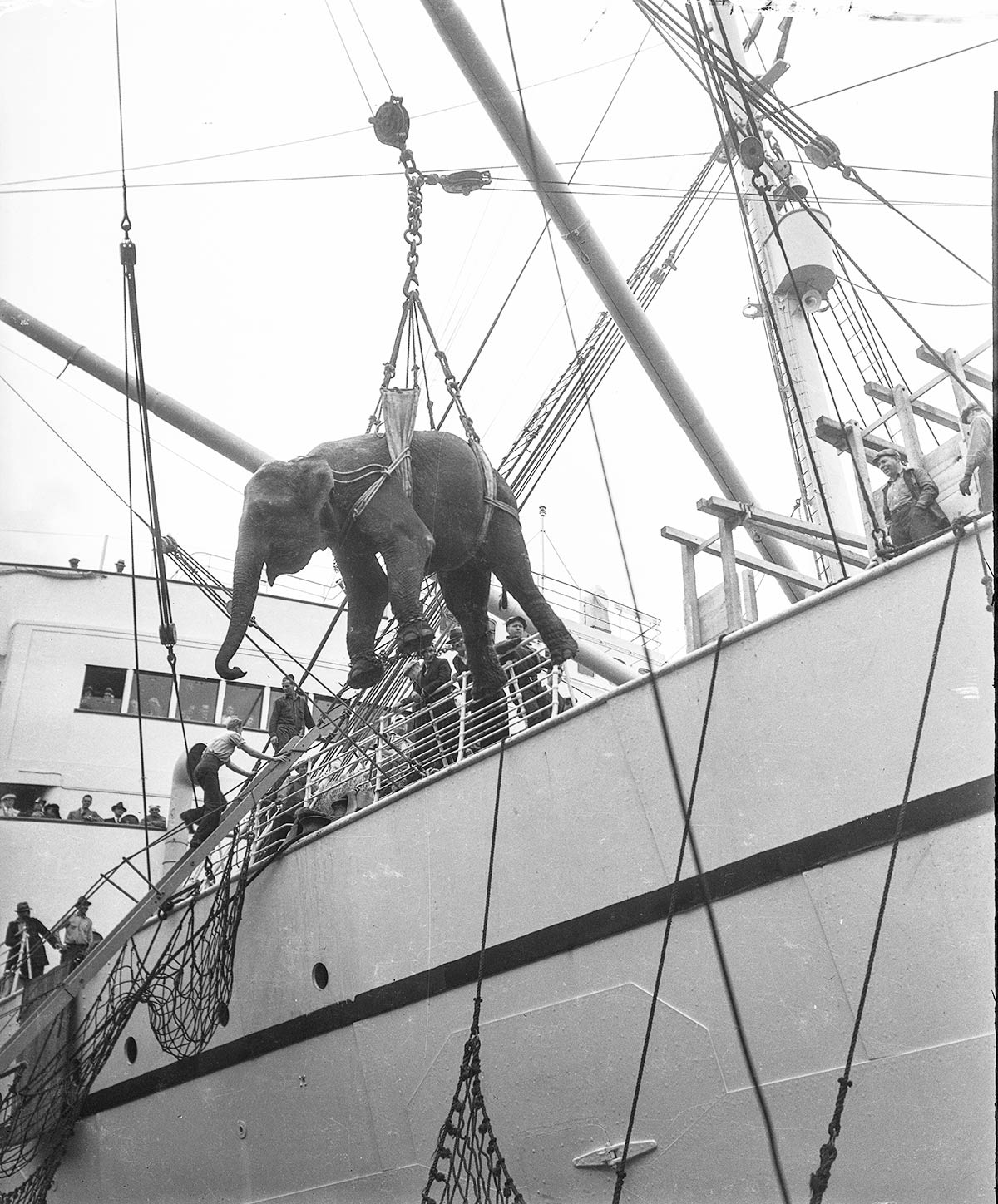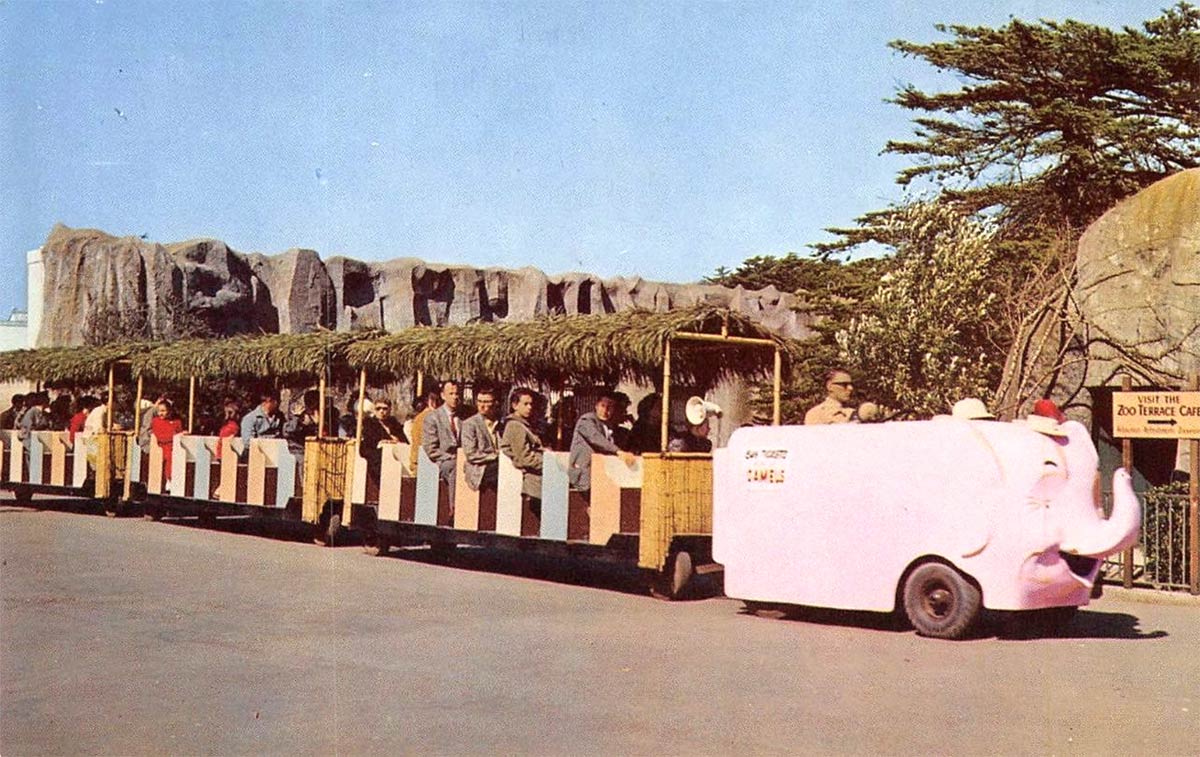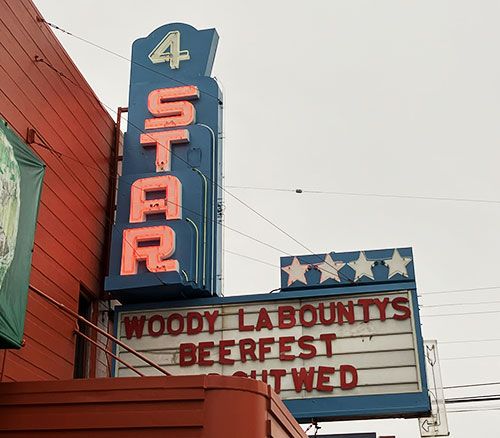Seeing the Elephant
The world's largest land mammals, metaphorical and real, in San Francisco history.

“Seeing the elephant” was a popular 19th century Americanism describing an adventurous experience, usually obtained at great cost.
Wikipedia has a nice description of the metaphor: “Elephant ‘sightings’ often begin with excitement and high ideals only to be disappointing or disenchanting. The high excitement followed by frustration epitomizes the elephant as something most wanted to ‘see’ but few would have wanted to ‘see’ again.”
Kinda like paying for tickets to see The Cars at the Cow Palace in 1982.
The elephantine expression was frequently used in the 1849 California Gold Rush. Miners poorer in the pocket, if richer in stories, would write of seeing the elephant as morally instructive. Here’s a typical example from 1849:
“I have just returned from the diggings a wiser if not a sadder man. I have ‘seen the Elephant’ and am now returning to the regions of civilization with a trustful hope that greed of gain will never tempt me again to endure hardships and dangers.”

The first instance of real elephants in San Francisco may have been a decade after, when “Prince Albert” and “Queen Victoria” arrived at the Vallejo Street wharf on May 17, 1859. They had been 158 days at sea from New York and the Alta noted they made the voyage “without any qualms of stomach, and with no symptoms of dyspepsia.”
These were seasoned, talented elephants: “One plays upon the organ with all the ease and elegance of a Dutch girl [umm, ok], and the other dances, a measure somewhere between a polka and the Virginia breakdown.”
Power’s Dancing Elephants

Speaking of dancing elephants, the pair seen above performed as part of Keith’s Vaudeville show at the Golden Gate Theater in 1925 and 1926. William Walter Power’s elephants originally appeared in the Walter L. Main Circus and transitioned into a vaudeville act in the early 1900s. Power’s pachyderms worked the Hippodrome Theater in New York City, and some sources claim the show was the first American elephant act on an indoor stage.
“Lena,” “Jennie,” “Ada,” and “Lou” played baseball, bowled, and danced to whatever was in fashion, traveling around the world for forty years. (See the comments on this thread at The Circus Blog for more.)

Getting elephants across oceans couldn’t have been easy, and OpenSFHistory has the above 1930s San Francisco photograph (with no other information), showing it wasn’t the most pleasant experience for the poor creatures.
Mrs. Patchner Sees the Elephant(s)
Sometimes you go to see the elephant and sometimes the elephant comes to see you.

Golden Gate Park’s Children’s Playground used to have an elephant-ride attraction. The animals spent their off hours in an enclosure where the park nursery and maintenance yard are today between the Academy of Sciences and the playground.
On January 21, 1926, “Babe,” “Margy” and “Virginia” were headed back from their shift at the playground when they were startled and made a mad dash into the Sunset District.
Sending motorists upon the sidewalks of Lincoln Way, the trio trotted down 14th Avenue and onto Irving Street, chased by mounted police, park employees, and a ten-ton derrick truck.

After running through a fence in a vacant lot and bursting into the backyard of 1248 15th Avenue, the “three thundering elephants stopped, apparently to admire and trample Mrs. Pachtner’s well-kept flower beds.”
Perhaps Pachtner's name was close enough to “pachyderm” to help chill things out?
Cajoled and calmed by bananas, Babe was trussed and hoisted into the truck. The more tractable Margy and Virginia chaperoned their incarcerated partner back to the park on foot.
Elephantine End

I have fed an elephant. I have ridden an elephant. The elephant house at the San Francisco Zoo was a must-stop for me as a kid. We rode the elephant train. We had a zoo key in the shape of an elephant.

The gray wrinkled behemoths were usually found outside under equally gray foggy skies on a rectangle of concrete about the size of two Sunset District house lots.
We were separated by a low fence and a moat and, I suspect, a million other things.

Elephants are long-lived, highly intelligent, sensitive creatures. Despite what many of my circus friends might say, I think they are probably happier not being poked with hooks to do tricks or standing in a concrete pen being yelled at by 8-year-old me.
After a couple of notable deaths, the San Francisco Zoo removed the last of its elephants in 2005. The city’s Board of Supervisors mandated the zoo couldn’t get another unless without 15 acres of roaming space. The State of California banned circuses with exotic animals in January 2020.
There will be no more seeing of real elephants in San Francisco, even in Sunset flower gardens. But the next crop of gold miners are on their way, techies and VC moguls with A.I. riches on the mind. We can bet that when the bubble bursts (again) there will be lot of more metaphorical pachyderms sighted.
Come Join Me at the Vogue for Some SF Film Noir

Christine French, my colleague at SF Heritage, will be joined by TCM host Eddie Muller next Tuesday at the Vogue Theatre to talk Alfred Hitchcock, Film Noir, and the city’s distinctive architecture. This terrific program in a great neighborhood theatre is part of SF Heritage’s “Uncorked” summer lecture series. Get your tickets before it sells out and see you next Tuesday!

Woody Beer and Coffee Fund

The Woody beverage fund stayed solvent this week because Olfactory Brewing gave everyone who attended my sold-out show at the 4 Star Theater a free beer. The presentation was really about Beertown, but thanks to Olfactory, the mistaken marquee ended up being mostly true.
When do you want to get together for a coffee or adult beverage? Let me know! Thanks to all who have chipped in with a deposit to the Woody sociability bank.
Sources
“From the Mines,” Weekly Alta California, May 10, 1849, pg. 1
“Arrival of the Ship Wanderer, with the Elephants Prince Albert and Queen Victoria,” Daily Alta California, May 18, 1859, pg. 1.
“Three Elephants Run Amuck in S.F. Streets,” San Francisco Examiner, July 22, 1926, pg. 1.
“3 Elephants Go on Lark, Terrorizing Park Vicinity,” San Francisco Chronicle, July 22, 1926, pg. 1.


